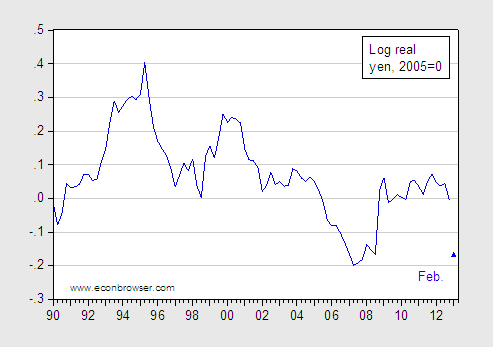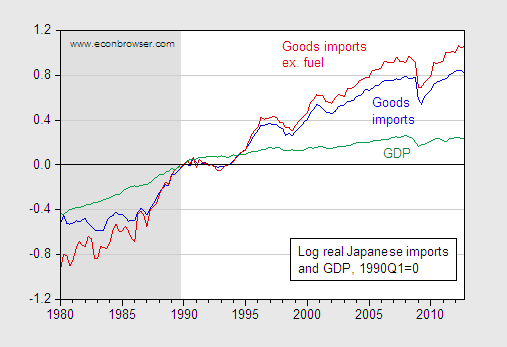One component of Abenomics is a vigorously expansionary monetary policy. The yen has depreciated substantially as a consequence — as of February, about 20% relative to 2012Q3. One question is how much of an expenditure switching effect this depreciation will induce. In order to examine this question, I have done some quick and dirty econometrics, summarized in this paper.

Figure 1: Log CPI-deflated trade weighted value of the Japanese yen, 2005=0. Source: IMF, IFS and author’s calculations.

Figure 2: Log real goods imports (blue) and goods imports ex.-fuel (red), and real GDP (green), rescaled to 1990Q1=0. Source: OECD, QNA, MoF, and author’s calculations.

Figure 3: Log real goods exports (blue) and real export-weighted rest-of-world GDP (green), rescaled to 1990Q1=0. Source: OECD, QNA, IMF, IFS, and author’s calculations.
In short, my estimates suggest that non-fuel goods imports respond with about unit elasticity to real exchange rate changes, while exports respond with an elasticity of about 0.7, over the 1990-2012 sample period. The Marshall-Lerner conditions are thus satisfied (nonfuel goods imports are about 2/3 of total goods imports, so even if fuel imports have zero elasticity, the condition would still likely hold).
These estimates differ slightly from those reported by Crane et al. (2007), who worked with a sample over the 1980-2006 period. They find exports that imports are relatively insensitive to price changes, while the export price elasticity is about 0.34. More recent estimates(Thorbecke, 2012) suggest that the export elasticity is between 0.44 to 0.61.
That being said, there is considerable uncertainty surrounding the estimates, since the point estimates vary with real exchange rate measure (CPI deflated or ULC deflated), and the treatment of time trends. The estimates of import income elasticities in particular (but all elasticities in general) are particularly sensitive. Inspection of Figure 2 suggest why this is the case; during the sample period, import penetration rises considerably. That phenomenon is captured by the time trend (or trends), so differing treatments provide differing estimates of the income elasticity.
Overall, the evidence from past studies as well as these estimates suggests that a yen depreciation can aid in boosting aggregate demand. The question remains open whether impacts (for instance, higher energy prices arising from dollar denomination of fuel imports) might mitigate these positive effects.
I just quickly scanned your paper. I noticed on page 5 your equation (8) is missing a right bracket.
This from Goldman’s new 380 Report on key oil projects around the globe:
Western oil Majors require $120/bl to be cash flow neutral
The oil price required for the western oil Majors to be free cash flow neutral after capex and dividends is much higher than is implied by the major new projects. On our estimates it has increased from c.$80/bl in 2008-11 to over $120/bl currently, as a result of higher decline rates, increasing maintenance capex and higher costs. Clearly this is not sustainable at a long-term oil price of $85/bl, and we believe that the majors would likely cut elements of the investment plan before modifying dividend payouts.
This is very bad, and confirms the my ongoing concerns about capex compression. I find it hard to see how the oil supply doesn’t peak out here. If a cash flow neutral position is $120 Brent and the global carrying capacity is around $115, then incremental capacity growth is largely precluded.
Very bad.
Nothing dirty in these econometrics results,in the public accounts, Banking and financial accounts, equities markets,these results are called creative accounting.
@Steve, “This is very bad, and confirms the my ongoing concerns about capex compression. I find it hard to see how the oil supply doesn’t peak out here. If a cash flow neutral position is $120 Brent and the global carrying capacity is around $115, then incremental capacity growth is largely precluded.”
Steve, one of the primary issues missed by economists and so-called cornucopians is that they assume that higher prices equal incremental innovation and increasing supply of substitutes. Falling global crude oil production and oil exports per capita during the past 7-8 years should be sufficient to prove otherwise. Flat to falling global food production per capita hasn’t convinced them yet. Little or no growth of real GDP per capita in the US, EU, and Japan is neither sufficiently convincing.
Global crude oil production per capita is on a similar trajectory as that of the US in the mid- to late 1970s, i.e., the onset of US deindustrialization and financialization. Although the meme has yet to take hold in the global mass mind, global industrialization is peaking with China-Asia utterly dependent upon energy imports and hundreds of billions of dollars of western and Japanese FDI per year (not invested in the US, EU, and Japan, BTW).
Note that China’s oil imports are now converging with those of the US (net imports are still behind the US by 3 Mbbl/day), creating the risk of deteriorating trade and diplomatic relations between the US and China in the years ahead, as well as the risk of conflict in the Pacific, Africa, and the Americas as China is forced to secure resources abroad.
Historically, a rising regional hegemon expanding abroad in search of resources has been one of the primary causes of geopolitical conflict and world war.
In this context, China growing at 13-14% nominal in Yuan terms (doubling time of just 5 years) and energy consumption growing at 8% with conditions of Peak Oil, peak or falling global food production per capita, and $110 Brent makes China more of a national security threat to the US, EU, and Japan than Radical Islam ever could be.
Strictly speaking, it is the US which is a threat to China. That China’s oil consumption is so low is a historical anomaly due to its oppression under communism. Had China developed like South Korea or Taiwan, we would have adjusted our consumption primarily in the 1985-2000 time frame.
Notwithstanding, the competition for energy is fraught with risks, I agree.
Steven, China would not have developed to anywhere near its current level without US and Japanese supranational firms’ investment of nearly $4 trillion and counting since the early 1990s. China is an artifact of the peak Oil Age era and “globalization”, i.e., the Anglo-American imperial trade regime (offshoring, labor arbitrage, FDI, etc.).
But the history of the past 250 years contains four previous periods, e.g., White Lotus Rebellion, Opium Wars, Boxer Rebellion, and Mao’s revolution, separated by 50-60 years, when westerners rushed to the Middle Kingdom to make their fortunes; however, each time coincided with a Long Wave deflationary era (as we have today), resulting in Chinese reaction against the West, seizing of assets, expulsion of foreigners, economic and financial crises, xenophobia, social unrest, and the Chinese leadership reacting against the population and turning inward from the rest of the world to deal with internal instability.
I expect human nature and history to rhyme yet again in the years ahead, only this time with 7 billion people in planetary ecological overshoot at Peak Oil.
Bruce and Steven,
China is a massive land of hidden treasure. Very little of China has been explored for oil reserves. When China feels world oil prices so high they hurt, they will increase their domestic exploration and that could lead to a huge increase in world reserves.
I know it is an unknown now, but this is pretty much what happened in the US. Texas was pretty much agriculture and wasteland until January 19, 1901 when Spindletop blew.
Ricardo, China has reached the “middle-income trap” in terms of GDP per capita just as demographics are peaking and the country becomes a net importer of energy and food.
China’s growth boom is over. China is 40-80 years too late to the auto-, oil-, and debt-based mass-consumer (un)economic model.
China’s economy will “rebalance” but only because FDI will contract with fixed investment, production, and exports as a share of GDP. China’s trade deficit will subtract from GDP hereafter.
Just a 1-1.5% contraction in FDI as a share of China’s GDP risks a Great Depression-like contraction at some point in the future from the FDI multiplier to fixed investment, production, and exports.
China will grow old before growing rich.
Bruce,
Yes, the demographics of China are shifting to an older population, but never forget, China is a command economy with ruthless leaders. The elderly will just be cast aside to die. China will not be strangled with a bloated social system even though they are “communist” (or perhaps because they are communist – Stalin and Mao anyone!)
I also agree with you to a point on FDI, but China is already moving away from the US toward Asian markets, pulling things back home. Much of their FDI is just finding a home for their bloated holding of dollars.
China also has a huge untapped domestic market. If they can figure out how to use their natural resources to fund domestic production they will continue to grow.
Their primary detriment is the same as their strength in demographics. Their command system will go a long way in strangling domestic production.
They are walking a fence. Which side will they come down on is still an open question.
@Ricardo: “China also has a huge untapped domestic market. If they can figure out how to use their natural resources to fund domestic production they will continue to grow. . . . They are walking a fence. Which side will they come down on is still an open question.”
I invite you to take a closer look at the natural resources per capita, the cost of further developing “domestic production” per capita and a western-like mass-consumer market, and the effects of imports on GDP.
We westerners are again making the same mistake of extrapolating endless growth of the Middle Kingdom (and riches for us) that our historical predecessors made four times before since China last peaked in the 18th century (and world population commenced its unprecedented growth until the unsustainable super-exponential rate that began in 1950).
But now China is again peaking and this time with the West, Peak Oil, peak food production, global population overshoot, and an effective peak in urbanization and industrial/post-industrial growth.
No, it’s not a popular narrative, and definitely not one on which a politician can be elected, economist can get tenure, nor a CEO keep his job if int’l growth is the firms’ objective.